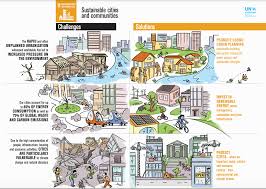Sustainable Urban Design Examples
Urban areas are facing increasing challenges due to rapid population growth and climate change. Sustainable urban design offers solutions that not only address these challenges but also create vibrant, liveable cities for residents. Here are some inspiring examples of sustainable urban design from around the world:
The High Line, New York City, USA
The High Line is a prime example of adaptive reuse in urban design. This elevated park was built on a disused railway line and transformed into a green space that promotes biodiversity and provides recreational areas for residents.
Vauban, Freiburg, Germany
Vauban is a sustainable neighbourhood in Freiburg known for its car-free streets, energy-efficient buildings, and emphasis on public transport and cycling infrastructure. The community prioritises renewable energy sources and has significantly reduced its carbon footprint.
Singapore’s Supertrees at Gardens by the Bay
The Supertrees at Gardens by the Bay in Singapore are iconic structures that serve as vertical gardens, generating solar power and collecting rainwater. These futuristic tree-like towers showcase the integration of nature with technology in urban environments.
The Bicycle Architecture Biennale, Global
The Bicycle Architecture Biennale showcases innovative designs that promote cycling as a sustainable mode of transportation in cities worldwide. From bike-friendly bridges to elevated cycle paths, these projects demonstrate how urban design can encourage eco-friendly mobility options.
Masdar City, Abu Dhabi, UAE
Masdar City is a planned sustainable urban development that prioritises renewable energy, water conservation, and zero-carbon emissions. The city utilises smart technologies to reduce energy consumption and create a carbon-neutral environment for its residents.
These examples highlight the importance of integrating sustainability principles into urban design practices to create resilient cities that can thrive in the face of environmental challenges. By learning from these innovative projects, urban planners can inspire future developments that benefit both people and the planet.
Exploring Sustainable Urban Design: Examples, Principles, and Community Involvement in Enhancing City Life
- What are some examples of sustainable urban design projects?
- How can sustainable urban design improve quality of life in cities?
- What are the key principles of sustainable urban design?
- Are there any successful sustainable urban design initiatives in the UK?
- How can communities get involved in promoting sustainable urban design?
What are some examples of sustainable urban design projects?
When exploring examples of sustainable urban design projects, several notable initiatives stand out for their innovative approaches to creating environmentally friendly and liveable cities. Projects such as The High Line in New York City, Vauban in Freiburg, Singapore’s Supertrees at Gardens by the Bay, the Bicycle Architecture Biennale, and Masdar City in Abu Dhabi showcase how urban design can integrate green spaces, energy-efficient buildings, renewable energy sources, and sustainable transportation solutions to enhance the quality of life for residents while minimising environmental impact. These projects serve as inspiring models for future urban developments that prioritise sustainability and resilience in the face of urbanisation challenges.
How can sustainable urban design improve quality of life in cities?
Sustainable urban design plays a crucial role in enhancing the quality of life in cities by creating healthier, more liveable environments for residents. By incorporating green spaces, pedestrian-friendly infrastructure, and efficient public transport systems, sustainable urban design promotes physical activity, reduces pollution levels, and enhances overall well-being. Additionally, sustainable practices such as energy-efficient buildings and renewable energy sources help mitigate climate change impacts, leading to cleaner air and a more resilient urban landscape. Ultimately, sustainable urban design not only improves environmental sustainability but also fosters social cohesion and economic prosperity, making cities more inclusive and enjoyable places to live.
What are the key principles of sustainable urban design?
Sustainable urban design encompasses a set of key principles that guide the development of environmentally-friendly and liveable cities. These principles include prioritising walkability and cycling infrastructure to promote active transportation, integrating green spaces and biodiversity to enhance urban ecosystems, implementing energy-efficient buildings and renewable energy sources to reduce carbon emissions, fostering community engagement and social equity to create inclusive neighbourhoods, and adopting smart technologies for efficient resource management. By adhering to these principles, sustainable urban design can address pressing environmental challenges while improving quality of life for residents in cities around the world.
Are there any successful sustainable urban design initiatives in the UK?
In the UK, there are several successful sustainable urban design initiatives that serve as inspiring examples of innovative city planning. One notable project is the BedZED (Beddington Zero Energy Development) in London, which showcases sustainable architecture, energy-efficient buildings, and renewable energy sources. Additionally, the Eden Project in Cornwall demonstrates how abandoned industrial sites can be transformed into thriving eco-friendly spaces that promote biodiversity and environmental education. These initiatives highlight the UK’s commitment to sustainable urban design and serve as valuable models for future developments aiming to create more liveable and environmentally conscious cities.
How can communities get involved in promoting sustainable urban design?
Communities play a crucial role in promoting sustainable urban design by actively engaging in the planning and development process. One way for communities to get involved is by participating in public consultations and providing input on proposed urban projects. By sharing their perspectives, concerns, and ideas, residents can influence decision-making towards more sustainable outcomes. Additionally, communities can organise local initiatives such as tree planting campaigns, cycling events, or neighbourhood clean-ups to promote environmental awareness and advocate for green spaces within urban areas. Collaborating with local authorities, businesses, and non-profit organisations can also help communities implement sustainable practices and initiatives that benefit both the environment and the well-being of residents. By fostering a sense of ownership and collective responsibility, communities can contribute significantly to creating greener, healthier, and more liveable cities for all.
